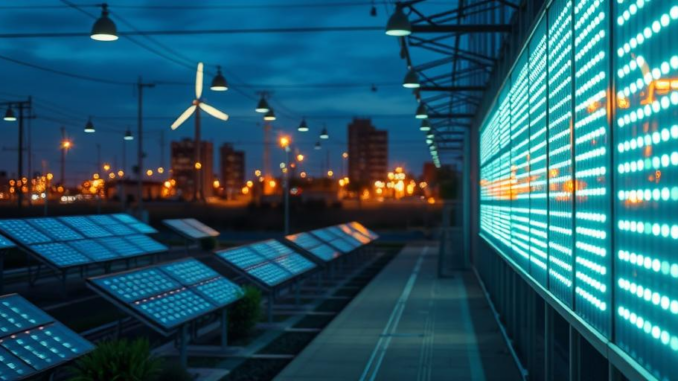
Summary
This article provides a comprehensive guide to improving building energy efficiency with LED lighting. It explains the benefits of LEDs, offers a step-by-step process for upgrading, and explores advanced energy-saving strategies like smart lighting and controls. Transitioning to LEDs not only reduces energy consumption and costs but also enhances sustainability.
Successful low-energy building design hinges on careful planning. Focus360 Energy can help.
** Main Story**
Alright, let’s talk about LEDs. Swapping out your building’s old lighting for LEDs? Seriously smart move. It’s not just about being ‘green’; it’s about boosting your bottom line too. Think about it: lower energy bills, a smaller environmental footprint, and, honestly, better light. So, how do you make the switch smoothly? Let’s dive in.
First Things First: Know Your Current Situation
First, you’ve got to assess your current lighting setup. A complete inventory. I mean, really get into it! What kind of bulbs are you dealing with – incandescent, halogen, fluorescent? What’s the wattage? Where are they located? Why? Because this deep dive will show you where you can make the biggest impact, saving the most energy. A quick win? You bet.
Picking the Perfect LEDs
Now, choosing the right LED bulbs. It’s not as simple as grabbing the cheapest ones, trust me I know. You’ve got to think about brightness (lumens), color temperature (Kelvin – that warm or cool light thing), and the shape of the bulb itself. And here’s a tip: always go for ENERGY STAR certified LEDs. They guarantee efficiency and performance. It’s like getting a seal of approval that says, ‘Yep, this thing will save you money.’
Matching the lumens is key. You want the brightness of the LED to match your old bulbs, not the wattage. A 9-watt LED can often do the same job as a 60-watt incandescent, and that is some serious saving! Finally, think about the vibe of the room. Warm white (around 2700K) is cozy for living spaces, but cool white (5000K) is better for kitchens or offices, places where you want crisp, clear light to, you know, get stuff done.
Installation Planning: DIY or Pro?
Are you going to handle the install yourself, or are you calling in the pros? I mean, if you’re just swapping bulbs, that’s one thing. But if you’re replacing whole fixtures, you might want to bring in an electrician. And, importantly make sure everything’s compatible, that’s a common mistake.
And while you’re at it, consider adding some extra bells and whistles like dimmers, timers, or even occupancy sensors. Little things that can save you even more energy down the line. You’ll kick yourself if you don’t!
Level Up: Smart Strategies for Max Savings
Okay, so you’ve got the basics down. Now, let’s talk about taking things to the next level. These are the strategies that can really make a difference.
Smart Lighting and Controls
Think smart LED lighting systems. We’re talking remote control, scheduling, dimming – all from your phone. It’s like having a personal lighting assistant. You can fine-tune everything to minimize energy waste, and who wouldn’t want that?
Harnessing Daylight
Daylight harvesting is a game-changer. I mean, why use artificial light when you’ve got the sun shining? Install daylight sensors that automatically adjust the artificial lights based on how much natural light is coming in. It’s not just smart; it’s elegant.
Occupancy Sensors
How many times have you walked into a room and the lights are blazing away, even though no one’s there? Occupancy sensors fix that. They turn the lights on when someone enters the room and off when they leave. Simple, effective, and it saves a ton of energy.
Keeping Things Clean
Regular maintenance matters. You’d be surprised how much dust and dirt can affect light output. Keep those fixtures clean to maintain optimal brightness and efficiency. It’s like keeping your car’s windshield clean – you see better, right? Well, your lights shine brighter too.
Don’t Forget the Free Money!
Seriously, do your homework and look into government incentives, utility rebates, and tax credits for energy-efficient lighting upgrades. It can significantly bring down your initial investment. Free money is always good, isn’t it?
So, what do you think? Ready to transform your building’s lighting into a lean, mean, energy-saving machine? I can tell you, it’s an investment that pays off, big time. And the best part? You’re not just saving money; you’re doing something good for the planet. And that, my friend, is a win-win.


So, beyond occupancy sensors, what about lights that follow you around the building like a caffeinated spotlight operator? Imagine the possibilities! Or is that just me wanting a little theatrical drama with my energy savings?
That’s a fun idea! A personalized lighting experience could add some flair to the workplace. Imagine the energy savings if only the occupied zones were brightly lit, while other areas remained dimmed. It combines efficiency with a touch of drama! Where can I sign?
Editor: FocusNews.Uk
Thank you to our Sponsor Focus 360 Energy
The point about matching lumens rather than wattage is crucial. Many people don’t realize how much more efficient LEDs are and end up over-lighting spaces. Considering the color temperature in relation to room function is another great tip for creating optimal environments.
Absolutely! Glad you highlighted the lumens vs. wattage point. It’s a common misconception. And you’re spot on about color temperature impacting the environment. Different spaces definitely benefit from different Kelvin ratings to optimize productivity or relaxation. It’s all about creating the right atmosphere while saving energy!
Editor: FocusNews.Uk
Thank you to our Sponsor Focus 360 Energy